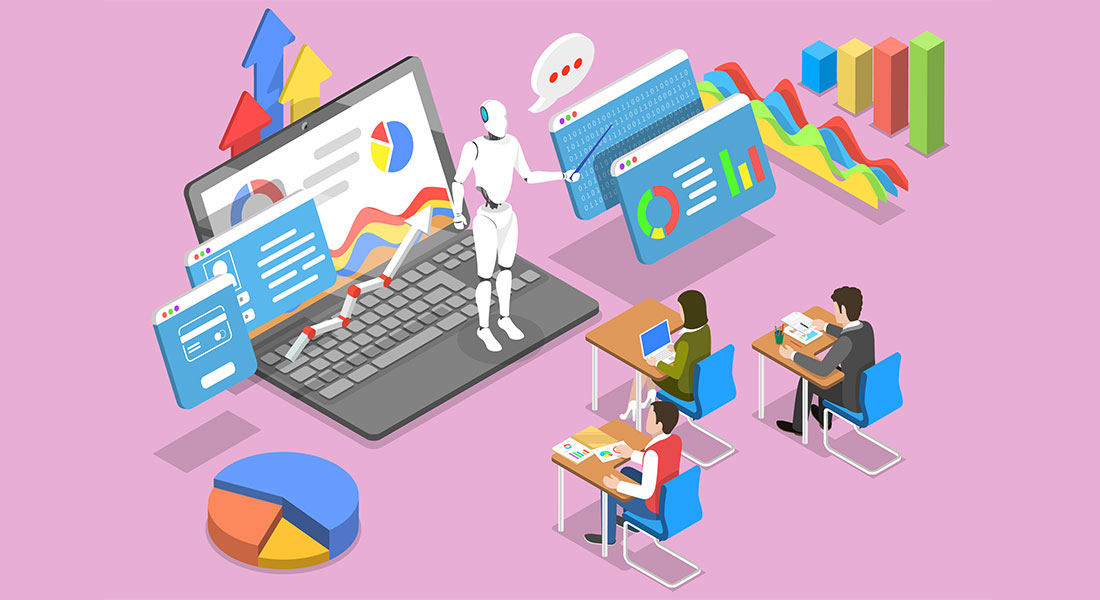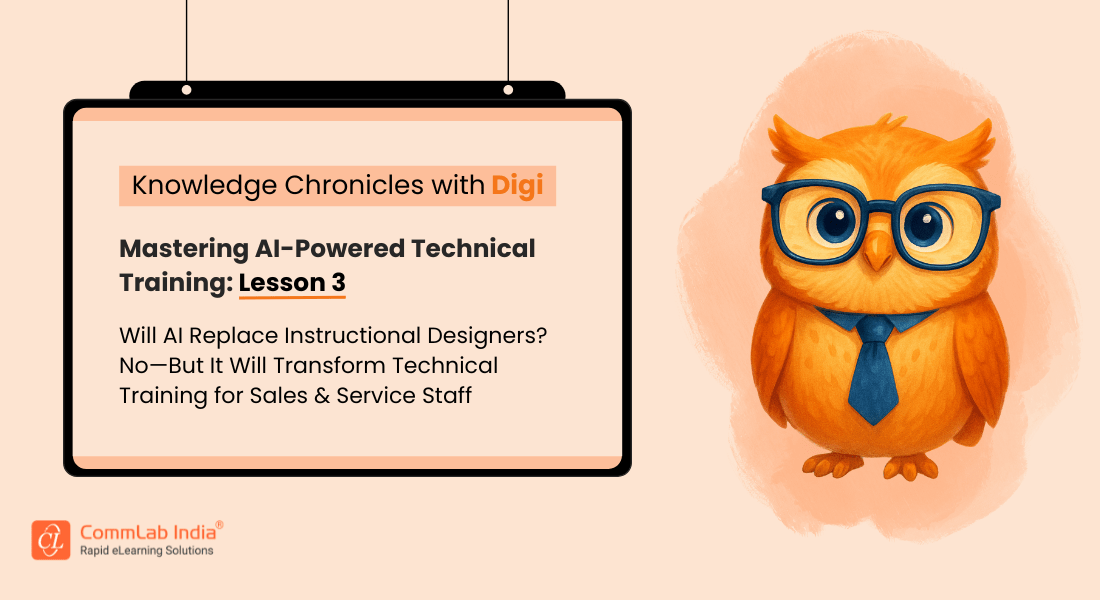Top 4 L&D Trends Impacted by AI Technology — Podcast Excerpt

AI is revolutionizing the way organizations approach Learning and Development(L&D) today. As AI technology continues to evolve, it not only enhances training methods but also transforms how employees acquire skills and knowledge. L&D professionals are now at the forefront of this transformation, leveraging AI to create more personalized, efficient, and impactful learning experiences that drive organizational success.
→ Download eBook: AI in Corporate Training
In this excerpt from our CommLab India’s eLearning Champion podcast, we explore the transformative impact of AI technology on trends in L&D. We’re joined by Shalini Merugu, Director of Learning Solutions at CommLab India, who brings over 18 years of experience in L&D consulting and solution design. In this discussion, Shalini shares her insights on how AI is revolutionizing corporate training, enhancing learner engagement, and redefining the future of learning.
Tune into the podcast for interesting insights!
Table of Contents
- Trend 1: AI's Transformative Role in Corporate Training
- Trend 2: Upskilling and Reskilling with AI
- Trend 3: Microlearning and AI
- Trend 4: Use of AI Tools for eLearning Design and Development Process
Top 4 Trends Impacted by AI Technology
Trend 1: AI's Transformative Role in Corporate Training

The journey began with eLearning and blended learning, with popular formats including course catalogs, online universities, and learning tools. Learning Management Systems (LMS) emerged as platforms for eLearning, enabling users to learn through online courses.
The next stage was talent-driven learning, focusing on learning paths and career tracks to facilitate career progression. The emphasis shifted towards using LMS as a talent platform.
Following that, digital learning and microlearning gained prominence, with formats such as videos, self-paced learning content, and YouTube tutorials. Learning Experience Platforms (LXPs) were introduced, offering on-demand learning embedded at the point of need.
LMS evolved from being primarily an eLearning platform to a platform designed to enhance the learner experience. The next progression was learning in the flow of work, making learning available anytime, anywhere, with a focus on upskilling and reskilling. Integration with software like Zoom and Teams became common, with LXP and LMS systems merging to offer comprehensive learning solutions.
Now, with the advent of AI, learning is ubiquitous, with AI-generated and curated content and AI-driven platforms taking center stage.
Trend 2: Upskilling and Reskilling with AI
According to McKinsey report, 82% of companies believe upskilling and reskilling must be at least half of the answer to addressing skills gaps.
With AI and big data taking center stage, these technologies are becoming the top priorities for corporate training. However, there's a significant snag: a shortage of training resources to meet the demand. And despite the tech hype, soft skills remain crucial. Skill gaps are major stumbling blocks for many companies, hindering transformation efforts and talent acquisition. Adding to the urgency, nearly half of workers' core skills are projected to change in the next five years. It's a race against time to prepare our teams and future-proof our organizations. So, let's not just focus on the present, let's gear up for what lies ahead.
Moving on to the skills, creative and analytical thinking take the lead, closely followed by technological literacy. This shifting landscape highlights the evolving nature of work and the need for continuous adaptation. They're doubling down on crafting effective strategies to upgrade their workforce
The World Economic Forum's Future of Work report also highlights the urgent need for upskilling and reskilling. Why is this a trend? Well, skills are evolving rapidly, and businesses are feeling the heat to keep pace!
Trend 3: Microlearning and AI
With upskilling and reskilling taking center stage, pushing us to find quick and effective solutions, microlearning is the best way ahead to meet challenges.
Microlearning when paired with AI, is gaining traction as a key trend in tackling this challenge. It's all about flexibility—microlearning adapts to different contexts, helping employees boost their performance and, in turn benefits the organization as a whole.
- Microlearning is a flexible learning approach used in multiple ways to enhance employee performance and business outcomes.
- It focuses on small, targeted objectives to facilitate the acquisition of new knowledge, skills, and abilities.
- The ultimate goal is to improve performance and generate desired results.

AI in Corporate Training
Partner, Not Replacement
- AI in Corporate Training
- AI Toolkit for Super-charged Learning
- Challenges to Consider with AI Implementation
- And More!
AI-driven Tools for Creating Microlearning Assets
Here’s an overview of AI-driven tools for creating microlearning assets in corporate training:
1. ChatGPT: Refines refines learning objectives, creates content summaries, and generates scenarios and group activities.
2. Midjourney, Stability.ai and Canva: Produce visually appealing graphics from custom prompts, offering a seamless visual experience for learners.
3. Vyond Go and Synthesia: Facilitate AI-driven video development, providing cost and time efficiencies for dynamic video content.
4. QuizBot & Prep AI: Streamline quiz and assessment creation, offering customizable options aligned with learning objectives.
5. Decktopus AI: Simplifies the creation of visually appealing presentations with a variety of templates and design options.
6. Repurpose.io: Generates engaging social media content to promote training sessions and foster learner participation.
Trend 4: Use of AI Tools for eLearning Design and Development Process
AI tools in eLearning design and development can be leveraged to accelerate the process. The initial step, as with any endeavor, involves identifying the learning objectives and content requirements. In this regard, AI can be instrumental in refining these parameters and even generating possible outlines based on the identified learning objectives. Subsequently, the second step entails thorough research to determine the appropriate AI tools to fulfill the eLearning requirements.
There exists a myriad of AI tools, each offering distinct features. Thus, this stage presents an opportune moment to deliberate and select the most suitable tools customized to our specific needs. Following this selection process, we progress to the subsequent step, which involves designing the core structure and learning activities for our courses to be interactive and engaging.
A pivotal aspect of this process is the identification of tools that facilitate rapid eLearning development, thereby expediting the course creation process. Moreover, the final step is crucial, as it entails piloting, testing, and refining the solution based on feedback garnered during pilot testing.
The integration of AI tools in eLearning design and development processes offers immense potential for efficiency and efficacy improvements. These tools not only streamline content creation but also contribute to better learning outcomes and business results.
Going Ahead
As we stand on the brink of a new era in corporate learning, equipping our workforce with the right AI tools is not just an option but a necessity for thriving in the future. Embracing AI technologies can unlock immense potential, drive enhanced productivity, spark innovation, and secure a competitive advantage in a rapidly changing marketplace. Organizations that invest in AI-driven training solutions are preparing their employees to meet the evolving demands of the modern workplace.
Discover how L&D professionals are leading the charge in training transformation with our comprehensive eBook. Learn how AI-powered reskilling can effectively bridge skill gaps in your organization. Download your essential guide today and unlock the potential of AI in your corporate training strategies!





